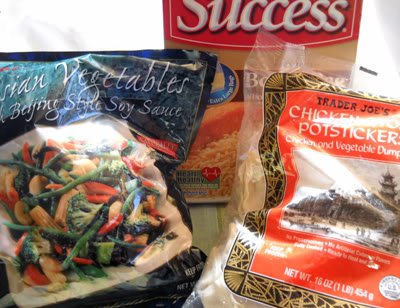
Last night’s dinner
I’ll let you in on a little secret: Sometimes, I use processed foods. Pretty much every day, in fact. Are you aghast? Well, don’t be. While the words “processed food” have become a dietary bugaboo, it’s just the teeniest bit misleading. When we talk about the problems Americans face with obesity, diabetes, and other nutrition-related illnesses, it’s much easier to blame processed foods as a category than it is to attempt to explain all the nuances involved. (And yes, I’m guilty of this myself.) But the fact is, unless you practice “clean eating”—there’s no official definition, but most define it as eating foods in as close to their natural state as possible—I’ll bet you have dozens of processed foods in your kitchen right now.
Got sliced bread? Processed.
Dry pasta? Processed.
Baby carrots? Processed.
Canned beans? Processed.
Flavored yogurt, all-fruit preserves, breakfast cereal? Processed, processed, processed.
You get the idea.
The thing is, most of us—and particularly the stretched-too-thin parents among us—need a little help to keep the family well-fed. When there’s no time to cook (an all-too-frequent occurrence, as even Pete Wells confessed in his final “Cooking with Dexter” column), having a stash of foods in the pantry that are nearly ready to go can tip the scale in favor of homemade vs takeout.
Reading labels is the key to buying processed foods. Before I even look at the marketing spiel on the front of the package, I turn it over and go straight to the nutrition facts statement. Seriously, don’t trust any claims on the front of the package—the food industry has so many ways to twist things it’s not even funny. My first stop on the nutrition facts: trans fats. We’re not supposed to eat any, ever, so this one’s easy. If it has any number other than zero, I put it down.
Next up: sodium. This is the biggest challenge when buying prepared (or semi-prepared) foods—manufacturers lean on salt to boost flavor, so even in products like ketchup, which doesn’t taste particularly salty, you may find an alarming amount. If your kid’s one of those ketchup-on-everything types, this can really add up. According to the American Heart Association, Americans average more than 3000 mg of sodium each day, while most health experts would prefer we take in no more than 1500. Aiming for 1500 mg breaks down to 500 total per meal, assuming all your snacks are sodium-free, which is hardly likely. This is tough to achieve, no doubt, so my rule has become to simply buy things with as little sodium as possible. If it says more than 500 mg per serving, most times I’ll pass it by. (Last night’s dinner, pictured above, goes against this rule! Clearly I make exceptions, mostly with Asian-inflected products.)
Once I’m satisfied with sodium, I look at fiber—it helps keep you feeling fuller longer, and it helps keep things moving inside your body, if you know what I mean. The trick here is that there are a lot of “fake” fibers in processed foods these days, now that fiber has become fashionable. So if the fiber count strikes me as being out-of-whack high (3 grams or more per serving for processed foods), I’ll check the ingredients list for things like inulin, maltodextrin, and polydextrose—manufactured fibers added to products to boost the fiber count. Technically they are indeed fiber, but the jury’s out as to whether or not our bodies actually use that fiber the way nature intended.
As long as I’m looking at ingredients, I’ll start at the top and read all the way through the list. If the first words aren’t actual foods—things I use in my own kitchen—and the foods that I expect to see in the product I’m holding, I put it down. If the first word is “sugar,” I put it down. And once I get past those first words, I make sure I recognize everything else on the list. If there are multisyllabic chemical-sounding words, I put it down. I’ll admit, short of having a degree in food science, it’s tough to know whether an ingredient is, in fact, dangerous—agar, a vegetarian gelatin substitute made from algae, seems to be safe, but it’s not something most of us keep in our kitchens. At this point it’s a gut-check for me; generally speaking, if the ingredients list has more than one or two things I don’t recognize, that’s enough to rule it out.
Once a product has jumped all these hurdles, the next jump is usually into my cart. It’s not a perfect system, for sure, but it works for me. It keeps us fed, especially on days when I’m too crazed with other things to actually cook—which happen more often than you might think, considering the whole “I’m a food writer” thing. Many of the items in what I call “The New Mom’s Pantry” are processed in some way, but they’re carefully chosen; the benefit outweighs the risk.
(If you’d like to learn a little more about how to relate a nutrition facts statement to your child’s needs, check out my story in the February/March Kiwi magazine, “Just the Facts.”)
How about you? If you buy processed foods, how to you determine which to buy?
